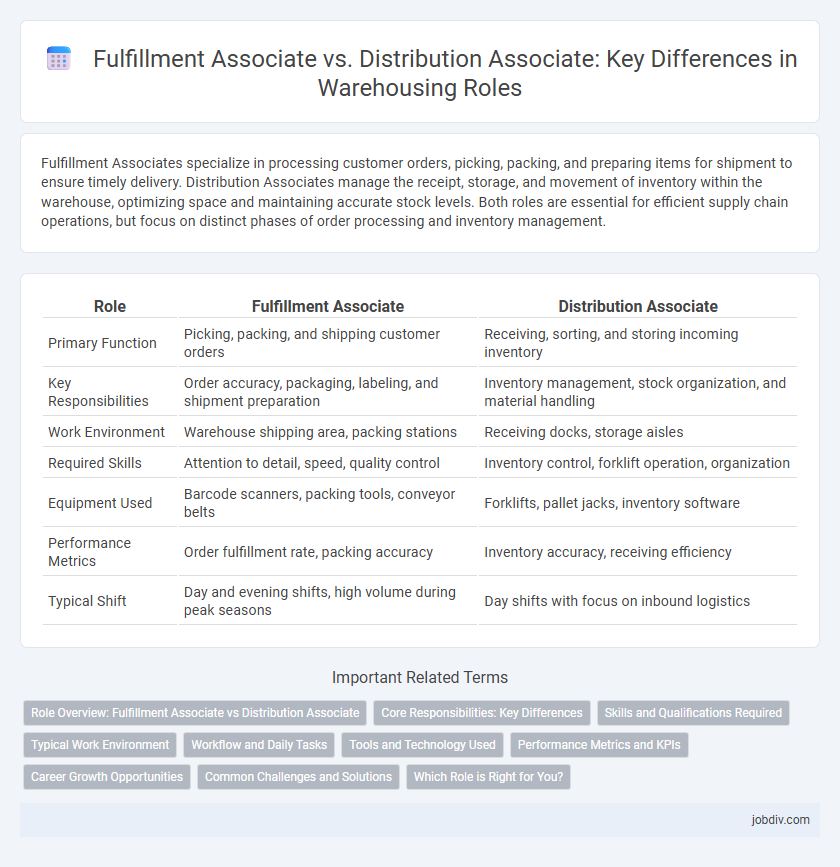Fulfillment Associates specialize in processing customer orders, picking, packing, and preparing items for shipment to ensure timely delivery. Distribution Associates manage the receipt, storage, and movement of inventory within the warehouse, optimizing space and maintaining accurate stock levels. Both roles are essential for efficient supply chain operations, but focus on distinct phases of order processing and inventory management.
Table of Comparison
| Role | Fulfillment Associate | Distribution Associate |
|---|---|---|
| Primary Function | Picking, packing, and shipping customer orders | Receiving, sorting, and storing incoming inventory |
| Key Responsibilities | Order accuracy, packaging, labeling, and shipment preparation | Inventory management, stock organization, and material handling |
| Work Environment | Warehouse shipping area, packing stations | Receiving docks, storage aisles |
| Required Skills | Attention to detail, speed, quality control | Inventory control, forklift operation, organization |
| Equipment Used | Barcode scanners, packing tools, conveyor belts | Forklifts, pallet jacks, inventory software |
| Performance Metrics | Order fulfillment rate, packing accuracy | Inventory accuracy, receiving efficiency |
| Typical Shift | Day and evening shifts, high volume during peak seasons | Day shifts with focus on inbound logistics |
Role Overview: Fulfillment Associate vs Distribution Associate
Fulfillment Associates focus on order processing, picking, packing, and preparing products for shipment to ensure accurate and timely delivery. Distribution Associates manage the receipt, storage, and organization of inventory within the warehouse, focusing on efficient material handling and stock management. Both roles are crucial for optimizing warehouse operations, with Fulfillment Associates prioritizing customer order accuracy and Distribution Associates ensuring inventory availability and flow.
Core Responsibilities: Key Differences
Fulfillment Associates primarily focus on picking, packing, and preparing orders for shipment, ensuring accuracy and timely dispatch. Distribution Associates manage the receipt, storage, and movement of inventory within the warehouse, optimizing space and tracking stock levels. The core difference lies in fulfillment associates handling outbound order processes, while distribution associates oversee inbound logistics and inventory control.
Skills and Qualifications Required
Fulfillment Associates require strong organizational skills, attention to detail, and proficiency in inventory management software to accurately pick, pack, and ship orders. Distribution Associates need physical stamina, the ability to operate forklifts or pallet jacks, and knowledge of supply chain logistics to efficiently receive, sort, and distribute products within a warehouse. Both roles demand teamwork, time management, and adherence to safety protocols to maintain seamless warehouse operations.
Typical Work Environment
Fulfillment Associates typically operate in fast-paced warehouse settings focused on picking, packing, and shipping customer orders with precision and speed. Distribution Associates work in distribution centers where they handle receiving, sorting, and organizing inventory for efficient product flow to retail locations or customers. Both roles require standing for long periods and operating warehouse equipment, often in temperature-controlled environments to maintain product integrity.
Workflow and Daily Tasks
Fulfillment Associates primarily manage order picking, packing, and labeling, ensuring accuracy and timely shipment, while Distribution Associates focus on receiving, sorting, and organizing inventory within the warehouse. Workflow for Fulfillment Associates involves processing customer orders through inventory systems and preparing products for delivery, whereas Distribution Associates coordinate inbound shipments and maintain stock levels to support fulfillment operations. Daily tasks for Fulfillment Associates emphasize order accuracy and shipment deadlines, whereas Distribution Associates prioritize inventory control and efficient product placement.
Tools and Technology Used
Fulfillment Associates primarily utilize warehouse management systems (WMS), barcode scanners, and automated picking tools to efficiently process and pack customer orders. Distribution Associates rely on conveyor systems, RF handheld devices, and inventory tracking software to manage the receipt, storage, and shipment of goods within the supply chain. Both roles integrate advanced technology such as RFID and real-time data analytics to optimize warehouse operations and ensure accuracy.
Performance Metrics and KPIs
Fulfillment Associates are primarily measured by order accuracy rate, picking speed, and on-time shipment percentage, reflecting their efficiency in processing customer orders. Distribution Associates focus on inventory accuracy, dock-to-stock cycle time, and load optimization to ensure smooth warehouse flow and cost-effective distribution. Both roles emphasize productivity metrics but differ in operational priorities aligned with order fulfillment and inventory movement.
Career Growth Opportunities
Fulfillment Associates typically gain expertise in order picking, packing, and shipping processes, positioning themselves for roles in inventory management or logistics coordination. Distribution Associates often develop skills in receiving, sorting, and dispatching goods, which can lead to advancement into supply chain supervision or warehouse operations management. Both roles offer pathways to higher responsibilities, but Fulfillment Associates may have more opportunities in e-commerce and customer service-oriented logistics.
Common Challenges and Solutions
Fulfillment Associates and Distribution Associates often face challenges such as inventory inaccuracies, order fulfillment errors, and time management pressures within warehousing operations. Implementing barcode scanning technology and real-time inventory tracking systems significantly reduces errors and improves order accuracy for both roles. Cross-training staff in both fulfillment and distribution tasks enhances operational flexibility and mitigates workflow bottlenecks during peak demand periods.
Which Role is Right for You?
Fulfillment Associates focus on picking, packing, and shipping orders accurately to meet customer demands, making this role ideal for those who prefer detail-oriented tasks in a fast-paced environment. Distribution Associates handle receiving, storing, and organizing inventory, which suits individuals who enjoy logistics and managing warehouse workflows. Choosing the right role depends on whether you thrive in order processing precision or inventory management and operational efficiency.
Fulfillment Associate vs Distribution Associate Infographic

 jobdiv.com
jobdiv.com